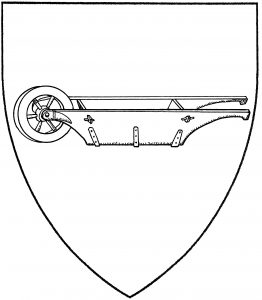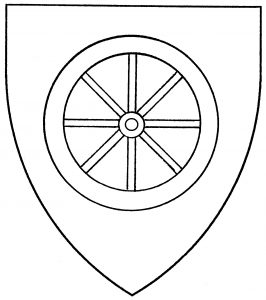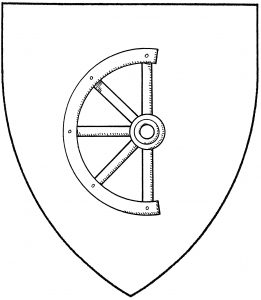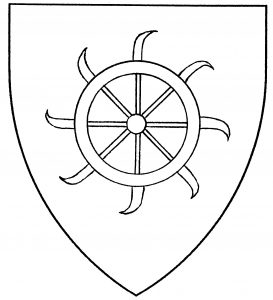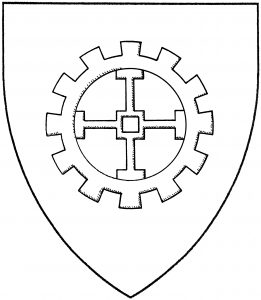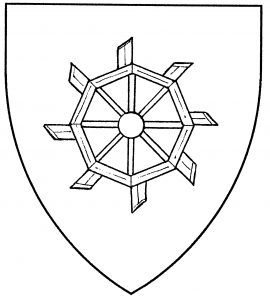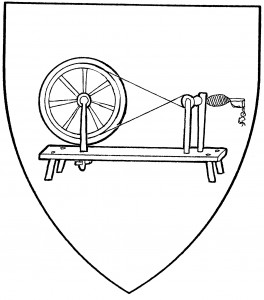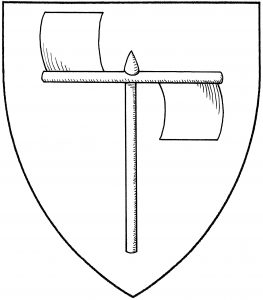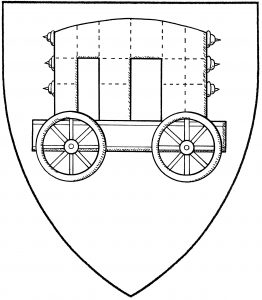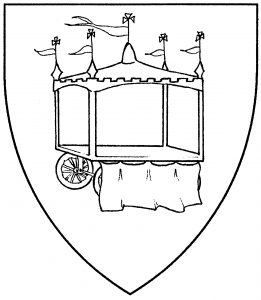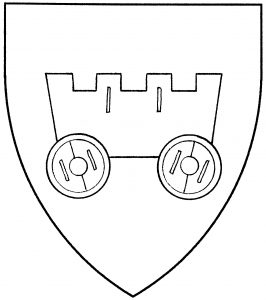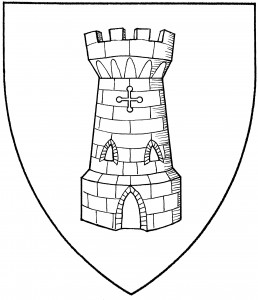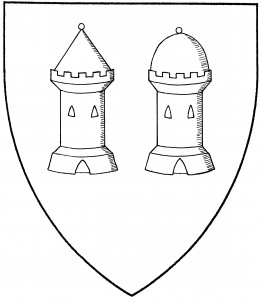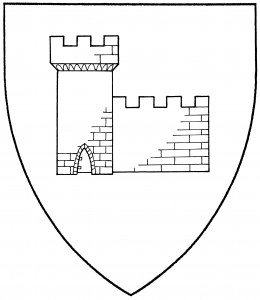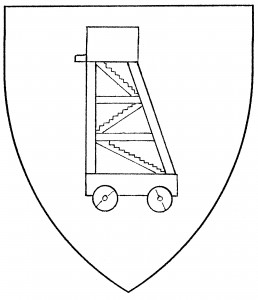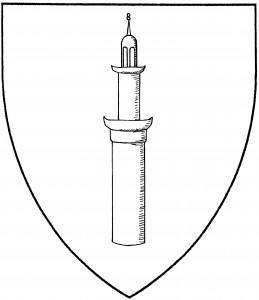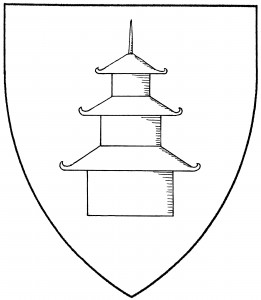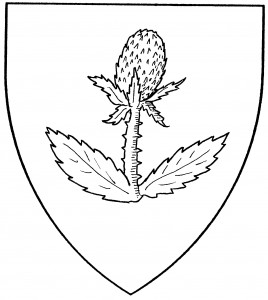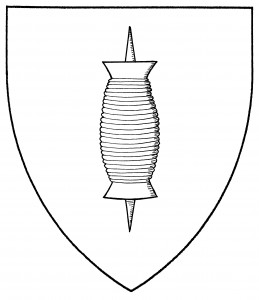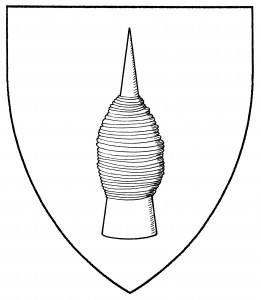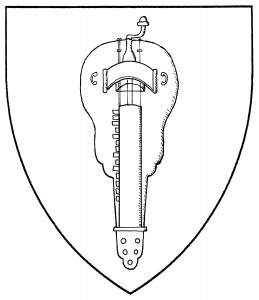Hannes zum Eichhorn bears: Per fess vert and Or, a wheelbarrow and an acorn counterchanged.
Search Results for: wheel
Wheel
Particularly in German heraldry, we find examples of partial wheels: a quarter-wheel, as in the arms of von Billick, 1605 [Siebmacher 71], or a half-wheel, as in the arms of Rusetzker [Siebmacher 73]. The orientation of the partial wheel (e.g., “dexter half of a wheel”, as in the illustration) must be specified in blazon.
Variants of the wheel include the “Catherine’s wheel”, the symbol of the martyr St. Catherine, with curved knife-blades radiating from the rim. As an heraldic charge, it’s found in the arms of Brentingham, Bishop of Exeter 1370-94 [DBA3 443]. There is the “cog-wheel”, also called a “gear-wheel” or “mill-wheel”, with an embattled outer edge, used in mechanisms from tiny clockworks to giant mill-works; it’s found in the canting arms (German Mühle, “mill”) of Mülinen c.1460 [GATD 20v]. Finally, there is the “water-wheel”, unique to Society armory, with vanes on the outer edge to draw power from running water. See also grindstone, spinning wheel.Cyprian of the Wheel bears: Argent, a wooden cartwheel of twelve spokes proper.
Caterine Barré de Venoix bears: Barry azure and Or, a Catherine wheel gules.
Iathus of Scara bears: Ermine, a cog wheel gules.
Patrick MacFynn bears: Per chevron vert and azure, a chevron argent between two natural dolphins embowed respectant Or and a water wheel argent.
Catherine de la Loire bears: Purpure, a Catherine’s wheel missing the dexter chief quarter between three fleurs-de-lys argent.
Spinning wheel
A spinning wheel is a tool for making thread; it is sometimes termed a “wool wheel”. It has a large wheel turning a single spindle, on which the thread is spun; period wheels were turned by hand, not by a foot treadle. Though a period artifact, the spinning wheel has not been found in period armory. The illustration is taken from the Luttrell Psalter, c.1340; it is the earliest known depiction of the artifact.
The spinning wheel has its spindle to sinister by Society default. See also distaff, drop-spindle.
Eloise of Roed bears: Argent, a wool wheel, alighting on the head a crow proper.
Edwinna of Hawk’s Bluff bears: Azure, three spinning wheels with spindles to dexter argent.
Effym Cowie Murray bears: Argent, a spinning wheel reversed sable.
Whirligig
The Order of the Whirligig, of the Barony of Delftwood, bears: Azure, a whirligig argent.
Wagon
A two-wheeled variant, the “oxcart” (Italian baroccio), is found in the canting arms of di Barozi, mid-15th C. [Triv 76].
Society variants of the wagon include the “covered wagon”, with a cloth covering stretched over circular hoops; the illustration is taken from the Douce psalter, c.1320. Similar is the “pageant wagon”, a wheeled performance stage, with curtains and ornamentation, used in 15th Century England. Finally, there’s the “war-wagon”, with an embattled top and arrow slits. None of these variants have yet been attested in period armory; moreover, the pageant wagon carries a step from period practice. For related charges, see wheelbarrow.The Baron of Nottinghill Coill bears as a badge: Or, a pageant wagon gules, its pennon staves and pennons azure, and its frontal curtain azure charged with a cross Or.
Æsa the Fierce bears: Vert, a wagon within an annulet argent.
Gunnora Aldyne bears: Azure, on a pale between two carts argent, a mouse rampant azure.
Alail Horsefriend bears as a badge: Per fess azure and argent, a war-wagon counterchanged and enflamed to sinister chief proper.
Tower
A tower is a fortified edifice, roughly cylindrical with an embattled top; the door faces the viewer by default. The tower is frequently depicted with a cruciform arrow-slit facing the viewer; this is frequently left unblazoned. When blazoned “proper”, the tower is grey (i.e., argent), the color of stone. The tower is often drawn masoned, even when not explicitly blazoned so.
The top of the tower is subject to variation. A “tower triple-towered” has three tiny towers issuant from its top, as in the arms of Amcotte or Amcots, c.1550 [BSB Cod.Icon 291:94]. A tower may be “spired”, with a conical roof, as in the arms of Harta or Harsdorf, mid-16th C. [BSB Cod.Icon 308:372]. Or it may be “domed”, hemispherically by default, as in the arms of Burnsen, 1562 [BSB Cod.Icon 265:122]; the Society has examples of “onion-domed” towers as well.
A tower may be conjoined to a wall extending to sinister, as in the arms of Tour de Vinay, c.1370 [Gelre 50]. It may be “ruined” or “ruinous”, with the foundation intact but the top crumbled away. A “tower enflamed” has flames issuant from the top, and often the windows as well.
Finally, there are the tower variants unique to the Society: The “pagoda” is an Buddhist temple building with characteristic eaves. The “minaret”, associated with mosques, is a spire with a balcony near the top, where the muezzin may call the Faithful to prayer. The “siege tower”, or “belfroi”, is a wheeled siege engine which permits attackers to climb into a castle while safe from the defenders; it faces dexter by default, and its “proper” coloration is wooden brown.
Period heralds drew no distinction between the tower and the castle, treating them interchangeably; the exact blazon was often chosen solely for a cant, as with the arms of Towers, c.1310 (bearing what we would deem “castles” though the cant makes them towers) [ANA2 169]. Society heraldry distinguishes the castle from the tower for the sake of the artist, but grants no heraldic difference. For related charges, see lighthouse. See also bridge, wall.
The Baron of the Lonely Tower bears: Quarterly sable and gules, in pale a tower and a laurel wreath argent.
The Shire of the Isles bears: Barry wavy argent and azure, a tower within a laurel wreath gules.
Ann of the White Tower bears: Sable, a tower argent.
William of Hoghton bears: Per bend sinister sable and Or, in bend two towers counterchanged.
Adrian Buchanon bears: Per pale wavy azure and gules, a pale wavy between a tower argent, portalled to sinister, and a wooden siege tower proper.
Margherita di San Gimignano bears: Per bend argent and azure, a conical tower erminois.
Alysandra the Whyte Moor bears: Per bend sinister vert and argent, an onion-domed tower Or and a dragon’s head couped at the shoulder gules.
Joella of Blue Lion’s Keep bears: Per fess argent and azure, a lion passant and a tower conjoined to sinister with a wall, all within a bordure counterchanged.
Ito Nori bears: Per fess Or and sable, three flames and a pagoda counterchanged.
Yolanda del Campo de Cerdana bears as a badge: Counter-ermine, in fess a minaret and a dome conjoined at their bases argent illumined Or.
Tools
Tools are implements to help in building or making. The term can be applied very broadly, but is usually understood to refer to the hand tools employed in industry or artisanry.
For woodworking tools, see: adze, awl, axe, chisel, drawknife, float, gimlet, hammer, knife, plane, saw. See also nail, square.
For metalworking tools, see: anvil, graver, hammer, punch, tongs.
For tools involving cloth, clothing, or thread, see: broach, drop-spindle, hempbreak, knife, loom, shears, spinning wheel. See also comb (wool), needle, quill of yarn, shuttle, spool of thread.
For gardening or agricultural tools, see: adze, axe, fork, harrow, hoe, plough, pruning hook, rake, scythe, sickle, spade, trowel.
For tools related to food and drink preparation, see: brewer’s scoop, fork, frying pan, knife, mash rake, pot, spoon, strainer. See also cleaver, oven, sieve.
For building or stoneworking tools, see: axe, chisel, hammer, knife, level, pick, saw, trowel. See also ladder.
For other entries, see: brush, grozing iron, press, shave.
Teazel
The teazel, or teasel, is a spiny flower used in dressing or fulling cloth; it is sometimes more fully blazoned a “fuller’s teazel” for that reason. It is a period charge, found in the arms of the Worshipful Company of Fullers, 1510 (later incorporated into the Clothworkers, 1530) [Bromley & Child 48]. Unlike most flowers, the teazel is shown in profile by default.
The teazel could either be blazoned “slipped and leaved”, as shown as in the illustration; or only the head might be shown, blazoned a “teazel’s cob” or “teazel’s head”. For related charges, see thistle.
Liadan Chu bears: Argent, three teasels slipped and leaved vert, between two flaunches purpure each charged with a triquetra fesswise one point outward Or.
Anne la Trouvere bears: Vert, a teazel slipped and leaved and on a chief Or three lozenges azure.
Beatrix Elizabeth de Lara bears: Quarterly azure and argent, in bend sinister a teazel head and a Catherine’s wheel sable within a bordure counterchanged.
Quill of yarn; Spindle
A quill of yarn is a cover for a spindle, onto which thread or yarn is wound; it can then be easily removed for use. Mundanely, it’s also known as an “embroiderer’s quill”. The blazon should include reference to yarn or embroidery, to help distinguish it from a “quill pen”.
The quill of yarn is a period charge, dating to 1558 in the arms of the Worshipful Company of Broderers [Bromley & Child 31]. It’s palewise, and wound with yarn, by default. There are instances in mundane armory of empty quills, without yarn, such as the arms of von Haren, 1605 [Siebmacher 147], but the fact is always blazoned.
The “spindle” itself is also found, the winding piece of a spinning wheel. It’s drawn as a slender cone wound with thread or yarn; it’s found in the arms of Hobby, 1610 [Guillim1 204], where it’s blazoned as a “fusile upon a slipper”.
For related charges, see drop-spindle, lace bobbin, spool of thread. See also distaff, shuttle (weaver’s).
Katharina die Schneiderin bears: Vert, a bend wavy between two quills of yarn Or.
Molda ókristna Starradottír bears: Vert, three yarn quills argent threaded Or.
Maud verch Howell bears as a badge: Per bend sinister sable and argent, on a bend counterchanged, two spindles palewise gules and Or.
Hurdy-gurdy
A hurdy-gurdy is a stringed musical instrument, with a rounded wooden body and a keybox. The hurdy-gurdy is played by turning a rosined wheel with a crank; the wheel rubs the strings and acts like a violin’s bow. It’s a period instrument – the Sforza Book of Hours, c.1490, shows an angel playing a hurdy-gurdy – but no examples have been found in period armory.
The hurdy-gurdy has no defined default orientation, so it must be blazoned explicitly (e.g., “crank to chief”, as in the illustration).
Oscar Goerijs Goriszoon bears: Per bend Or and sable, a sword bendwise and a hurdy-gurdy bendwise, crank to base, counterchanged.
Gardner of Elyg bears: Argent, a skeleton statant affronty sable playing a hurdy-gurdy azure.
